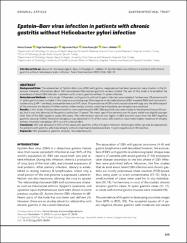| dc.contributor.author | Dursun, Nevra | |
| dc.contributor.author | Hacıhasanoğlu, Ezgi | |
| dc.contributor.author | Okcu, Oğuzhan | |
| dc.contributor.author | Paşaoğlu, Esra | |
| dc.contributor.author | Leblebici, Cem | |
| dc.date.accessioned | 2020-12-19T19:34:54Z | |
| dc.date.available | 2020-12-19T19:34:54Z | |
| dc.date.issued | 2020 | |
| dc.identifier.citation | Dursun, N., Hacıhasanoğlu, E., Okçu, O., Paşaoğlu, E., & Leblebici, C. (2020). Epstein-Barr virus infection in patients with chronic gastritis without Helicobacter pylori infection. The Turkish journal of gastroenterology : the official journal of Turkish Society of Gastroenterology, 31(3), 205–210. https://doi.org/10.5152/tjg.2020.18850 | en_US |
| dc.identifier.issn | 2148-5607 | |
| dc.identifier.uri | https://doi.org/10.5152/tjg.2020.18850 | |
| dc.identifier.uri | https://hdl.handle.net/11436/1197 | |
| dc.description | WOS: 000529401300002 | en_US |
| dc.description | PubMed: 32343232 | en_US |
| dc.description.abstract | Background/Aims: the association of Epstein-Barr virus (EBV) with gastric malignancies has been proven by many studies in the literature. However, information about EBV-associated inflammation/gastritis remains limited. the aim of this study is to establish the prevalence of latent EBV infection in patients with chronic gastritis without H. pylori infection. Materials and Methods: in this study, 119 patients with gastritis without H. pylori infection were included. Furthermore, 28 patients with H. pylori gastritis were included in the study as a control group. Chromogenic in situ hybridization (EBV-encoded RNA) and immunohistochemistry (LMP-1 antibody) were performed in all 147 cases. the prevalence of EBV and its relationship with age, sex, the affected part of the stomach, the density of inflammation, inflammatory activity, intestinal metaplasia, and atrophy were analyzed. Results: in this study, 14 cases showed positive immunostaining for EBV. EBV positivity was seen mostly in the lymphoid tissue (13 cases), but it was also detected at the gastric epithelium (7 cases). the mean age of the patients was 44 years, which was slightly younger than that of the EBV-negative cases (48 years). the inflammation density was higher in EBV-positive cases than the EBV-negative gastritis cases (p=0.002). Intestinal metaplasia was detected in 7% of the cases. EBV-positive cases had a higher incidence of atrophy without intestinal metaplasia (21% vs 3.8% without EBV). Conclusion: EBV was detected in 12% of the cases with gastritis without H. pylori infection. Endoscopic follow-up may be appropriate for patients with gastritis, who have atrophy without intestinal metaplasia and are H. pylori negative but EBV positive. | en_US |
| dc.language.iso | eng | en_US |
| dc.publisher | Aves | en_US |
| dc.rights | info:eu-repo/semantics/openAccess | en_US |
| dc.subject | EBV | en_US |
| dc.subject | Prevalence | en_US |
| dc.subject | Gastritis | en_US |
| dc.subject | Atrophy | en_US |
| dc.subject | Helicobacter pylori | en_US |
| dc.title | Epstein-Barr virus infection in patients with chronic gastritis without Helicobacter pylori infection | en_US |
| dc.type | article | en_US |
| dc.contributor.department | RTEÜ, Tıp Fakültesi, Cerrahi Tıp Bilimleri Bölümü | en_US |
| dc.contributor.institutionauthor | Okcu, Oğuzhan | |
| dc.identifier.doi | 10.5152/tjg.2020.18850 | |
| dc.identifier.volume | 31 | en_US |
| dc.identifier.issue | 3 | en_US |
| dc.identifier.startpage | 205 | en_US |
| dc.identifier.endpage | 210 | en_US |
| dc.ri.edit | oa | en_US |
| dc.relation.journal | Turkish Journal of Gastroenterology | en_US |
| dc.relation.publicationcategory | Makale - Uluslararası Hakemli Dergi - Kurum Öğretim Elemanı | en_US |


















